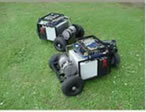Itchy and Scratchy

Humans, when faced with the task of lifting something heavy or bulky, tend not to go out and find the biggest, strongest person they can to accomplish the task. Rather they will find other people so that the task is distributed or shared. Traditional trends in robotics have gone the opposite way, bigger and more powerful robots were successively being constructed to deal with tasks such as cutting down and stripping forest trees. However, these robots are expensive to manufacture, difficult to transport and in the case of the forestry industry, they actually damage the ground due to soil compaction.
More recently, cooperative robotic interaction has been explored. There are numerous examples of applications for such collaborative robotics, not the least being that NASA realise the only way a space colony will be built is by robots as humans would be unable to carry all the necessary life support equipment required for the duration of such a project.
To explore this form of behaviour, two identical robots affectionately called “Itchy” and “Scratchy” were constructed. These robots are based on a tricycle arrangement with the steering wheel located at the back (in a similar manner to a forklift) in order to improve manoeuvrability.
Past projects:
Praneel Chand (2011),
Development of an Artificial Intelligence Systems for the Instruction and Control of Cooperating Mobile Robots.
Andrew Payne (2004),
Design and Construction of a Pair of Cooperating Autonomous Mobile Robots .
 Humans, when faced with the task of lifting something heavy or bulky, tend not to go out and find the biggest, strongest person they can to accomplish the task. Rather they will find other people so that the task is distributed or shared. Traditional trends in robotics have gone the opposite way, bigger and more powerful robots were successively being constructed to deal with tasks such as cutting down and stripping forest trees. However, these robots are expensive to manufacture, difficult to transport and in the case of the forestry industry, they actually damage the ground due to soil compaction.
More recently, cooperative robotic interaction has been explored. There are numerous examples of applications for such collaborative robotics, not the least being that NASA realise the only way a space colony will be built is by robots as humans would be unable to carry all the necessary life support equipment required for the duration of such a project.
To explore this form of behaviour, two identical robots affectionately called “Itchy” and “Scratchy” were constructed. These robots are based on a tricycle arrangement with the steering wheel located at the back (in a similar manner to a forklift) in order to improve manoeuvrability.
Humans, when faced with the task of lifting something heavy or bulky, tend not to go out and find the biggest, strongest person they can to accomplish the task. Rather they will find other people so that the task is distributed or shared. Traditional trends in robotics have gone the opposite way, bigger and more powerful robots were successively being constructed to deal with tasks such as cutting down and stripping forest trees. However, these robots are expensive to manufacture, difficult to transport and in the case of the forestry industry, they actually damage the ground due to soil compaction.
More recently, cooperative robotic interaction has been explored. There are numerous examples of applications for such collaborative robotics, not the least being that NASA realise the only way a space colony will be built is by robots as humans would be unable to carry all the necessary life support equipment required for the duration of such a project.
To explore this form of behaviour, two identical robots affectionately called “Itchy” and “Scratchy” were constructed. These robots are based on a tricycle arrangement with the steering wheel located at the back (in a similar manner to a forklift) in order to improve manoeuvrability.
